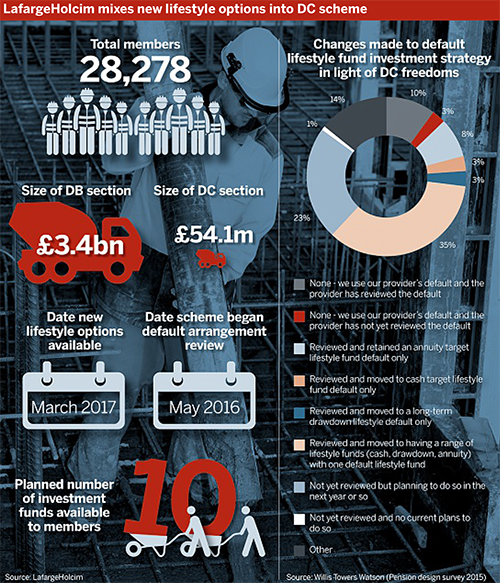Building materials giant LafargeHolcim has changed the default fund and administration of its defined contribution pension scheme following a value-for-money assessment.
Many schemes have conducted such reviews following the introduction of freedom and choice as they work towards enabling good member outcomes while ensuring value for money.
The trustees of the £54.1m DC section of the £3.4bn Lafarge UK Pension Plan found that members were receiving good value for money, but decided to make a number of changes “to improve good value”. This involved a change to the default fund. Although the default option was considered ‘acceptable’ over the short term, the scheme concluded that it was “not optimal value for money in the long term”.
If you’re not going to do a value-for-money review right, don’t do one
Chris Roberts, Dalriada Trustees
This involved a change to the default fund. Although the default option was considered 'acceptable' over the short term, the scheme came to the conclusion that it was “not optimal value for money in the long term”.
Increasing member choice
The new default lifestyle option has a lower level of risk in the growth phase and focuses on providing cash lump sums upon retirement. The other two new lifestyle strategies are being introduced for members who wish to use income drawdown or purchase annuities.
Harris said that the trustees decided on these changes “having undertaken extensive member profiling”. The new options will replace the default annuity lifestyle and annuity and cash lifestyle currently offered.
The trustees also chose to move to external administration provider Legal & General, because it offers a wider range of funds and options at competitive rates than the previous in-house system, said Harris.

Mark Futcher, partner at Barnett Waddingham, said that “it is fair to say that every DC scheme has discussed its default fund since freedom and choice, but not all have made changes”.
Lower cost does not mean better value
Regarding value for money, Futcher said that schemes “need to be very careful of the messaging to members on anything that could be mistaken as critical of value – unless of course it really is bad value – in which case the trustees have not done a very good job to date”.
When assessing value for money, “every aspect which contributes to making DC needs to be reviewed, such as administration, governance, providers, consultants and suppliers, communications and engagement, contributions, costs and charges, investment and at-retirement framework.”
Chris Roberts, professional trustee at Dalriada Trustees, said one of the most difficult aspects is “defining what value for money is”. A key concern is getting the best possible member outcomes and encouraging additional contributions while “doing whatever you can in terms of communications”.
Trustees should also be focusing on investments and making sure they are providing returns, he added.
Roberts said many trustee boards “paper over the cracks” with “a light touch value-for-money review”.
However, he emphasised the importance of being thorough, and said: “If you’re not going to do a value-for-money review right, don’t do one.”
Deciding on a default fund
Lee Hollingworth, partner and head of DC consulting at Hymans Robertson, noted that freedom and choice has prompted the majority of schemes to review their default funds.
He said: “The difficult question is, which one is the appropriate one to put your members in?”, adding that this is where “knowing your individual membership profile can be really useful”.
Hollingworth said that looking at the history of what members have done in the past five or 10 years is a good place to start.
When it comes to whether a member opts for cash or drawdown at retirement, “the primary influencing factor is pot size”, he said.
Other factors include looking at members’ history prior to the DC scheme. If an employer operated a defined benefit scheme, they have to consider whether this may make members who were in that scheme more likely to take their DC pot as cash.
However, Hollingworth noted that if pot sizes vary considerably between members, schemes can segment members into different approaches “according to what their likely retirement decision will be”.














